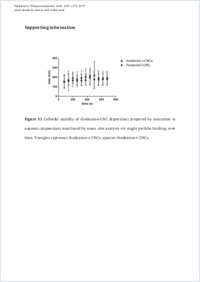Fate of cellulose nanocrystal aerosols deposited on the lung cell surface in vitro
- Endes, Carola Adolphe Merkle Institute, University of Fribourg, Switzerland
- Mueller, Silvana Adolphe Merkle Institute, University of Fribourg, Switzerland
- Kinnear, Calum Adolphe Merkle Institute, University of Fribourg, Switzerland
- Vanhecke, Dimitri Adolphe Merkle Institute, University of Fribourg, Switzerland
- Foster, E. Johan Adolphe Merkle Institute, University of Fribourg, Switzerland - Department of Materials Science and Engineering, Virginia Tech, Blacksburg, Virginia, United States
- Petri-Fink, Alke Adolphe Merkle Institute, University of Fribourg, Switzerland - Department of Chemistry, University of Fribourg, Switzerland
- Weder, Christoph Adolphe Merkle Institute, University of Fribourg, Switzerland
- Clift, Martin J. D. Adolphe Merkle Institute, University of Fribourg, Switzerland
- Rothen-Rutishauser, Barbara Adolphe Merkle Institute, University of Fribourg, Switzerland
-
13.04.2015
Published in:
- Biomacromolecules. - 2015, vol. 16, no. 4, p. 1267–1275
English
When considering the inhalation of high-aspect ratio nanoparticles (HARN), the characterization of their specific interaction with lung cells is of fundamental importance to help categorize their potential hazard. The aim of the present study was to assess the interaction of cellulose nanocrystals (CNCs) with a multicellular in vitro model of the epithelial airway barrier following realistic aerosol exposure. Rhodamine-labeled CNCs isolated from cotton (c-CNCs, 237 ± 118 × 29 ± 13 nm) and tunicate (t-CNCs, 2244 ± 1687 × 30 ± 8 nm) were found to display different uptake behaviors due to their length, although also dependent upon the applied concentration, when visualized by laser scanning microscopy. Interestingly, the longer t-CNCs were found to exhibit a lower clearance by the lung cell model compared to the shorter c-CNCs. This difference can be attributed to stronger fiber–fiber interactions between the t-CNCs. In conclusion, nanofiber length and concentration has a significant influence on their interaction with lung cells in vitro.
- Faculty
- Faculté des sciences et de médecine
- Department
- Département de Chimie
- Language
-
- English
- Classification
- Chemistry
- License
- License undefined
- Identifiers
-
- RERO DOC 255795
- DOI 10.1021/acs.biomac.5b00055
- Persistent URL
- https://folia.unifr.ch/unifr/documents/304435
Other files
Statistics
Document views: 67
File downloads:
- fin_fcn.pdf: 283
- fin_fcn_sm.pdf: 120

